The Panama Canal and so much more
My adult daughter Jennie and I chose the line Cruise West (Seattle, WA; 888/851-8133, www.cruisewest.com) for our highly anticipated January ’06 trip through the Panama Canal plus Costa Rica.
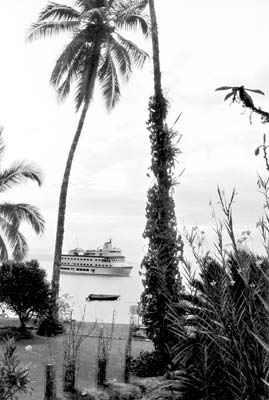
Cruise West is tops in small-ship cruising. Their ships, carrying only 94 passengers each, are totally unlike the megaships cruising the Caribbean and we really appreciate them.
They offer educational adventures to study the ecology of an area and the culture of the people who live there. We also like the close bond that develops between the passengers, who are of a like mind. These were serious travelers who had been everywhere and could share their adventures with each other.
We chose to fly to Panama City one day early. A representative of Cruise West met us and a bunch of other early birds at the airport and drove us to the very nice Caesar Park Hotel. The next morning the same rep picked up a small busload for an all-day sightseeing adventure. We toured Old Panama City and the new modern parts, the large Chinatown district and the very interesting Panama Canal Museum.
After leaving the city, our tour went to Gamboa, site of the U.S. Army barracks during the building of the canal but now a very attractive ecology resort and residential area. We took an hour-long aerial tram ride up over the jungle canopy to a high lookout point.
Staying on the bus, we made the 2-hour ride to the Caribbean port city of Colón, where we boarded the Pacific Explorer, a ship of Honduran registry with a Costa Rican crew, our home for the next 10 days.
The food on this trip was excellent — all familiar things with tasty Costa Rican flavors.
The ship’s “entertainment” each evening was an informative and interesting talk by one of our naturalist guides and a lecture about things we would see and do the next day. Highly educated and trained, these naturalists also were personable. They were always with us for our activities to answer questions and to help us get the most out of what we were seeing and doing.
Our first stop was at Wichubhuala, one of the 365 very small San Blas Islands, to visit the indigenous, self-governing Kuna Indians.
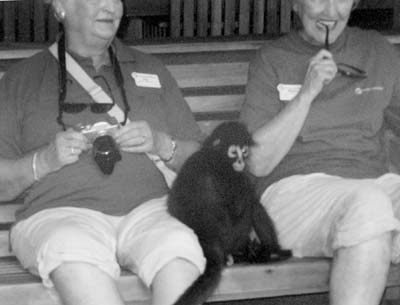
The women make very long strings of tiny beads, which they wrap around and around their legs from ankles to knees and around their arms from wrists to elbows. They are famous for their molas, hand-stitched appliquéd multilayer panels of fabric which may be framed or sewn onto a shirt, dress, handbag, etc.
The locals would pose for pictures for $1 each. We met the chief of the village, and some young folks did traditional dances for us.
We visited beautiful Portobelo, Panama, once one of the richest ports in the world and the commercial center for the Spanish colonies. At that time, it took three military forts to protect the port and the bay from pirates and buccaneers.
Besides the forts, of special interest in Portobelo was the statue of the Black Jesus Christ in the old Church of San Felipe. Every year or two the statue receives new robes that are made of velvet and very elaborately decorated with silver and gold trim. The old robes are on view in an attached museum.
There were no docks at the places we visited, so the ship would anchor quite a ways offshore and we would ride inflatable rubber crafts called Zodiacs to the beach, where we would jump into shallow water and wade ashore. Most mornings, there was an early-morning bird walk on shore that we could join.
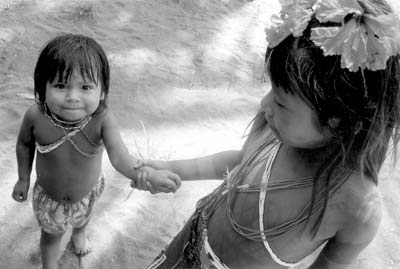
One particular day there was MUCH excitement aboard ship because it was the day we would go through the Panama Canal, the main reason we were there. We watched an excellent video, “A Man, A Plan, A Canal: Panama” (available online), and learned about the history of the canal, the many problems connected with the digging and building, which took 10 years, and the operations and maintenance today. The whole thing is mind-boggling, and it was so exciting to actually be there.
We went through the first set of locks at Gatun in daylight, then had the excitement of continuing through the locks at Pedro Miguel and Miraflores at night with fluorescent lighting. The 50-mile trip took about seven hours and was one of the unforgettable events of my lifetime.
Cruise West is permitted to visit the Embera Indians in their village of Playa de Muerto in the Darién Jungle. We had the wonderful experience of spending the day with these shy, gentle, friendly people. Their hospitality was overwhelming and genuine. We met the Chief and the Minister of Tourism. We were encouraged to walk around the village, often with little children holding our hands.
The village is very near the Colombian border, so three Panamanian soldiers are assigned to live there to protect the villagers from drug traffickers. The soldiers were friendly and just wandered around in their uniforms, carrying guns.
The Indians danced and sang for us. The little girls ages three and four were adorable and not shy about performing. After the men and women danced, they picked partners from our group to dance with them. What fun!
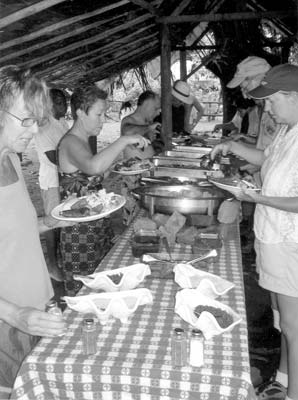
The Emberas make a few high-quality crafts, which they offer to sell, but they did not beg us to buy nor did they haggle over prices, which were very reasonable. They loved to have their pictures taken, especially with digital cameras so they could see themselves, but we were instructed not to give them any money or gifts because we were there as friends, not tourists.
The village men have cleared a really nice big soccer field in the middle of the jungle and play among themselves until Cruise West comes to visit, and then there is a big game against the crew from the ship. The game was exciting and well played, with good sportsmanship. The Embera won (as usual).
The next few days we visited several very secluded beaches, where we took hikes with our naturalists, enjoyed fantastic snorkeling and kayaking or just relaxed, swimming in crystal-clear warm water. At Coiba National Park we had our very own private little island.
Crossing over into COSTA RICA, we anchored in the Golfo Dulce (Sweet Gulf), where we visited Casa Orquideas Botanical Gardens, the private home and farm of Ron and Trudy McAllistar, who left New England 30 years ago to live in a Garden of Eden where there are exotic tropical birds, butterflies, the ever-present monkeys and countless varieties of flowers, including over 100 species of orchids.
We went to Cana Blanca, a refuge for jungle animals that have been rescued from various situations. You have to watch your eyeglasses, cameras, jewelry, etc., because the monkeys really want to have them. A man from our group had a serious tug-of-war with a monkey over his glasses. Fortunately, the man won or his glasses would have disappeared into the jungle.
Thirty-three percent of Costa Rica is preserved by the government in national parks. We spent one full day hiking and swimming at Caletas Beach in Corcovado National Park and another day at Manuel Antonio National Park. We had a barbecue picnic lunch on the beach, and the monkeys swarmed around but did not help themselves to the food, which surprised me.
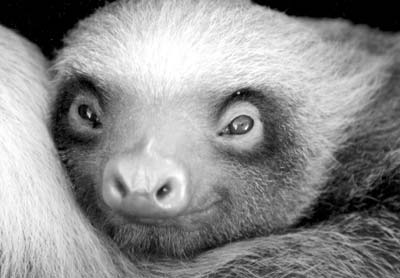
I probably should mention that we slathered DEET all over our bodies and were pretty successful in keeping bugs and insects away. I also used an SPF 45 sunscreen lotion, but most people didn’t need to have quite that much protection.
The early morning bird-watching and nature-observation hikes sometimes stretched into more than four hours because no one wanted them to end. The enthusiasm of the naturalists was as entertaining and interesting as the birds and animals we saw, and we saw a lot!
Participation in any of the many activities offered was always optional. There were always new friends to talk with or we could read or relax on the beach or on the ship’s sun deck.
The Pacific Explorer docked at Los Sueños, Costa Rica, and, after a very well-organized disembarkation, we all went our separate ways, some returning home and others continuing to travel. It was a 3-hour bus ride through beautiful countryside to the nice airport in San José.
We had wanted to see the Panama Canal, and we did, but this was so much more than we ever expected. Everything else was a bonus.
This trip was a bit more expensive than the budget prices of the megaships, but it was certainly worth it. We paid $3,500 each, which included discounts for booking and paying early and another discount because we had traveled with Cruise West before.
Of course, the price included all meals, excursions and entrance fees. Gratuities are neither required nor expected on Cruise West ships. We paid $600 each for our flights on Continental from Newark to Panama City and return from San José to Newark.
SANDY ROBSON
Brunswick, OH
